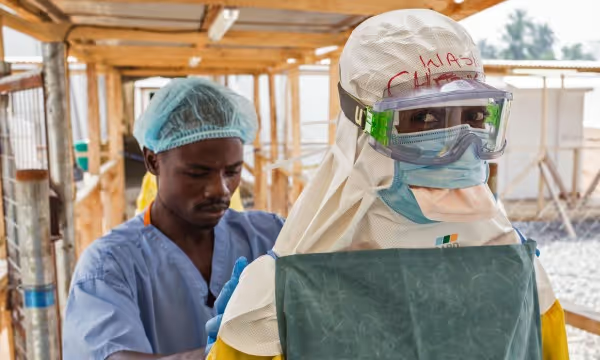Predicting the geographic spread of Ebola virus disease in West Africa

Project overview
The study aimed to develop models and software to quantify human movement patterns to predict the risk of Ebola transmission between and within countries, in order to guide targeting of surveillance and interventions.
Project solution
This project offers [specific solution or intervention] to tackle [challenge]. By implementing [strategies, tools, or innovations], the project aims to achieve [desired outcomes]. The approach is designed to [specific actions or methods] to bring about meaningful change in [community, region, or issue area].
Expected outcomes
This project aims to achieve [specific outcomes], such as [measurable results, improvements, or changes]. The expected impact includes [benefits to the target community, advancements in research or innovation, or long-term effects]. By the end of the project, we anticipate [specific changes or milestones] that will contribute to [broader goals or objectives].
Principal Investigator: Simon Hay, University of Oxford
Purpose:
The study aimed to develop and apply new mathematical models and software to quantify human movement patterns in the region to predict the risk of EVD importation between and within countries, in order to guide targeting of surveillance and interventions. These predictions are of greatest use during the growth phase of an outbreak, when the disease’s geographic extent is expanding. Because the EVD outbreak transitioned in December 2014-January 2015 from such a growth phase into a period of retraction, as the outbreak was brought under control, the need for regional predictive maps for the current outbreak lessened.
Whilst the project maintained the objective of providing continuously updated importation risk maps, there was an increased focus on developing these tools so that they can be implemented rapidly for future outbreaks. The study also adapted the outputs of this work to facilitate longer-term risk assessment and planning.
Outcomes:
Predictive statistical models of population movements in West Africa were developed which enabled predictive statistical models of the risk of the EVD importation into new regions. The models allowed for automatic updates as soon as new EVD data were available and the risk maps immediately disseminated via a dedicated website. Underlying this work was the development of three core pieces of software which were designed for ease of re-use and disseminated as open-source on the code-sharing website GitHub.
Ebola Modelling Pipeline
Python scripts and modules to automate downloading up-to-date Ebola data and statistics, preprocessing and handing off to predictive models using observed movement data.
[.cta_link]View GitHub page[.cta_link]
Key outputs:
- 4 peer review articles published (see below ‘Publications’ section for details).
- Regional Risk Maps - The automated mapping pipeline produced continuously updated maps of the risk of Ebola case importation into sub-national districts in the three affected countries and their neighbours.
- Global Risk Assessment Maps - The global models of EVD importation risk were incorporated into a global humanitarian risk assessment for Ebola led by DfID
- Software - The project developed three core pieces of software to enable rapid application of these methods for future outbreaks: a software package for the R programming environment to model human mobility; an automated software pipeline to make automated predictions of disease importation risk; and a website to automatically display these predictions.
- R package - The package will help facilitate research into the application of these models in humanitarian context, both for mapping disease spread and predicting population movements in response to catastrophes.
- Automated Mapping pipeline – the project team built a software pipeline to automatically check for new case data via WHO’s data portal.
;
[.slimline-cta-box][.slimline-cta_heading]R2HC Funding for Ebola Projects. A Rapid Response[.slimline-cta_heading][.slimline-cta_paragraph] In August 2014, the Ebola Outbreak in West Africa was declared an International Health Emergency by WHO and within a couple of weeks ELRHA launched a rapid-response call for research to combat the crisis. The UK Department for International Development (DFID), the Wellcome Trust and ELRHA opened a special funding window through the Research for Health in Humanitarian Crises (R2HC) programme.
The aim of this emergency call was both to produce robust research findings that could contribute to the effectiveness of the response to the current outbreak and help to draw lessons for future outbreaks of Ebola and other communicable diseases. The projects funded will strengthen the evidence base for the Ebola response in topics ranging from diagnostics to anthropology, surveillance and disease control.[.slimline-cta_paragraph][.slimline-cta-box]
Project delivery & updates
Stay up to date with the latest developments from this project. Here, you will find details on what has been delivered, resources created, and regular updates as the project progresses. Access key documents, reports, and other materials to see how the project is making an impact.
Resources
Journal article
LEARN MOREJournal article
LEARN MOREJournal article
LEARN MORE